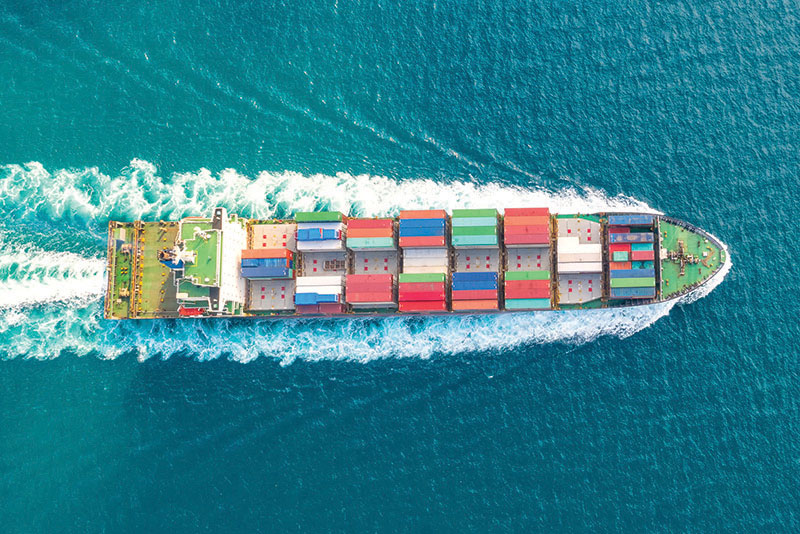U.S.-bound imports are heading back to pre-pandemic numbers, reports Port Tracker
Keeping in line with its previous edition, the new Port Tracker report, which was issued this week by the National Retail Federation (NRF) and maritime consultancy Hackett Associates, the theme of lower retail container import volumes, for the end of 2022 and into 2023, remained fully intact.
The ports surveyed in the report include: Los Angeles/Long Beach; Oakland; Tacoma; Seattle; Houston; New York/New Jersey; Hampton Roads; Charleston, and Savannah; Miami; Jacksonville; and Fort Lauderdale, Fla.-based Port Everglades.
Authors of the report explained that cargo import numbers do not correlate directly with retail sales or employment because they count only the number of cargo containers brought into the country, not the value of the merchandise inside them, adding that the amount of merchandise imported provides a rough barometer of retailers’ expectations.
“Ports have been stretched to their limits and beyond but are getting a break as consumer demand moderates amid continued inflation and high interest rates,” NRF Vice President for Supply Chain and Customs Policy Jonathan Gold said in a statement. “Consumers are still spending and volumes remain high, but we’re not seeing the congestion at the docks and ships waiting to unload that were widespread this time a year ago. It’s good to escape some of the pressure, but it’s important to use this time to address supply chain challenges that still need to be resolved like finalizing the West Coast port labor contract.
The report noted that import volume at the onset of the pandemic, in March 2020—at 1.37 million TEU (Twenty-Foot Equivalent Units)—fell to a four-year low, which, it observed, led to the temporary shutdown of much of the U.S. economy, with cargo levels rising on the heels of the pairing of shutdowns being lifted and pent-up consumer demand in the summer of 2020, as monthly imports compiled by the report topped the 2 million TEU mark, remaining at that level for an extended period, with the exception of only one month until November.
For November, the most recent month for which data is available, import volume for the ports covered in the report, came in at 1.78 million TEU, an 11.3% decline compared to October and a 15.8% annual decline. This represented the lowest monthly tally since February 2021, when it came in at 1.87 million TEU, the lone month in more than two years to come in below 2 million TEU.
Port Tracker issued projections for the subsequent months, including:
- December, at 1.88 million TEU, for a 10.1% annual decrease;
- January, at 1.91 million TEU, for an 11.5% annual decrease;
- February, at 1.63 million TEU, for a 23% annual decrease (and the lowest monthly tally since June 2020’s 1.61 million TEU, during a period of backed-up cargo and port congestion);
- March, at 1.75 million TEU, for a 25.5% annual decrease;
- April, at 1.94 million TEU, for a 14.5% annual decrease; and
- May, at 2 million TEU, for a 16.2% annual decrease
Should the December number come to fruition, the report explained that total 2022 volume would come in at 25.7 million TEU, which would be off 0.7% compared to the all-time annual record set in 2021, at 25.8 million TEU. What’s more, report pointed out that even with import levels down, 2022 retail sales remain positioned to hit the NRF’s 6%-to-9% growth estimate over 2021, contingent on final December retail sales numbers, which are set to be issued next week.
Hackett Associates Founder Ben Hackett wrote in the report that while the pandemic has impacted global trade and consumer demand for almost three years, there is evidence that conditions are returning back to pre-pandemic times, adding that freight rates have crashed in tandem with shipping demand, as well as container shipping profits falling, following what he called the days of “euphoric profits,” for the sector.
“We remain hopeful that the downward pressures on demand will be short-lived, with a return to growth by the second half of 2023,” wrote Hackett. “Despite a falloff in the second half, 2022 was bolstered by record-setting monthly totals in the first half of the year thanks mainly to continued strength at East and Gulf Coast [ports] as carriers shifted from congested West Coast docks. Compared with last spring’s strong showing, the first half of 2023, is forecast to experience a year-over-year import decline of nearly 17%, with the Transpacific trade suffering a drop of over 20%. Nonetheless, as inflation eases and consumer spending returns, we project that growth will slowly return going into the second half of the year.”













